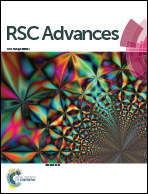Glycosylation of luteolin in hydrophilic organic solvents and structure–antioxidant relationships of luteolin glycosides†
Abstract
An effective approach was developed to biotransform luteolin glycosides in hydrophilic organic solvents. Bacillus cereus A46 cells showed high activity and stability in 5–20% (v/v) DMSO with 90–98% conversion rates of luteolin glycosides. Five glycosides of luteolin 7-O-β-glucoside, luteolin 4′-O-β-glucoside, luteolin 3′-O-β-glucoside, luteolin 7,3′-di-O-β-glucoside and luteolin 7,4′-di-O-β-glucoside were obtained. The addition of DMSO greatly promoted the solubility of luteolin and further regulated the formation of the main products from five luteolin glycosides to luteolin 7-O-β-glucoside (931.2 μM). Fourteen flavonoids and anthraquinones were used as tentative substrates. Glycosylation positions were located at the C-7, C-3′ or C4′ hydroxyl groups of flavonoids and C-5 hydroxyl group of anthraquinones. The 3′,4′-dihydroxy arrangement played the key role for the antioxidant activity of luteolin.



 Please wait while we load your content...
Please wait while we load your content...